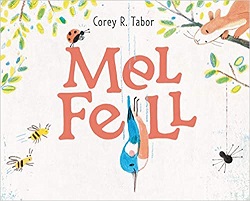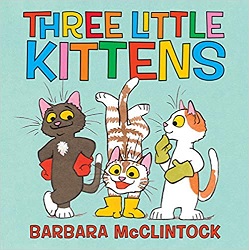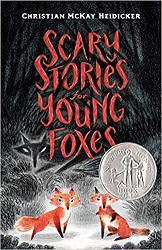Review of Mel Fell, by Corey R. Tabor
by Corey R. Tabor
Balzer + Bray (HarperCollins), 2021. 40 pages.
Review written July 10, 2021, from a library book
2022 Caldecott Honor Book
Mel Fell is a simple picture book with pizzazz. I love the way it plays with the format of the picture book to catch interest.
The book begins in an unusual position. You open the book with the spine up. Then we get a tale of a baby kingfisher named Mel who decides it’s time to fly. But when she stepped off the branch, instead of flying, Mel fell.
We’re zoomed in on Mel and see various creatures try to catch her – squirrels, bees, a spider – all to no avail. Then there’s a big “Oh no!” and Mel’s eyes that were serenely closed pop open.
But on the next page, there’s a big splash. Then we see underwater, where Mel catches a fish in her beak, and we’re cleverly asked to turn the book.
The rest of the book has Mel flying triumphantly out of the water (now with the spine of the book below the pages we’re turning) and up and up, past the creatures we saw on the way down, back to her nest.
It’s all fun and simple, with only a little text on each page, but a dramatic and easy-to-follow story.
An author’s note at the back explains that kingfishers dive into the water from trees. “A young kingfisher probably doesn’t catch a fish the first time they leave the nest. But then, Mel is a very special bird.”
coreyrtabor.com
harpercollinschildrens.com
Find this review on Sonderbooks at: www.sonderbooks.com/Picture_Books/mel_fell.html
Disclosure: I am an Amazon Affiliate, and will earn a small percentage if you order a book on Amazon after clicking through from my site.
Disclaimer: I am a professional librarian, but the views expressed are solely my own, and in no way represent the official views of my employer or of any committee or group of which I am part.
What did you think of this book?









